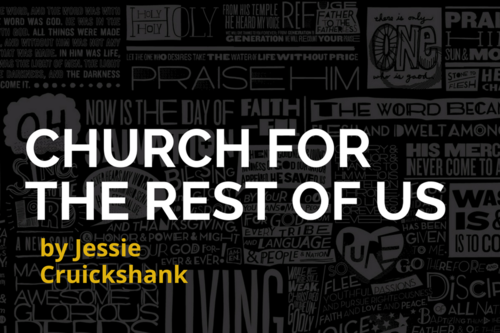One thing I always find interesting about church as we know it are the narratives and archetypes we have so unquestioningly accepted. I believe that for us to become a people of faith that can reach the whole word, these narratives should be teased out so that we can examine them and make choices on how to change them.
One way to identify a narrative is by looking at who is missing from our church bodies, or who is uncomfortable in them…and then find out why. The last few years has introduced me to a group often ignored or even shamed in our churches: introverts.
The typical evangelical church is not a friendly place for introverts, and the larger the congregation, the more uncomfortable the experience. If we walk through a new church experience with the eyes of an introvert, it might surprise us (better yet, ask an introvert how they experience your church).
Imagine being an introverted new believer who has never been to church and walking onto an unfamiliar church campus. How do you know where to go? How do you know what building or door to walk into? Most churches, due to their lack of signage or maps, create uncomfortable experiences for people.
Think about Disneyland.
You don’t have to ask where something is, there are signs everywhere. Street signs pointing the way to attractions and bathrooms. Campus maps everywhere to help you know how to find things. Whether Disney or your local mall, the designers want you to feel comfortable and like you belong. Churches, however, don’t think about that and often created a very unwelcoming experience for people. This causes new people, who don’t know where to go or where things are, to be reminded consistently that they are an ‘outsider’. This is not a welcoming feeling.
Instead of signs, churches often use people to help you know where to go or how to find things. This is great, unless you are new AND an introvert. The last thing you want to experience as an introvert is people coming up to you wearing a colored t-shirt and giving you a download of information and relational energy. If you are not already exhausted in trying to find out where to park, how to find the front door, or the bathroom, you will be by the time you past 7 well-meaning extroverted greeters.
Then let’s think about worship. Let’s say I’m a creative introvert. What does your worship look like for me? If I sit and contemplate Christ, will people be looking at me or will an usher ask me if I am okay? If I want to paint or draw, do I have a place to worship in your church? Most worship in the evangelical church is designed for extroverts. This is even more so in pentecostal churches (which I say as a proud Pentecostal). Liturgical churches have worship more amenable to introverts, with their chants, meditations, and hymns of lament. I know more than a few introverts who have changed denominations because the worship style was more conducive to their personality and life-giving to them.
The next terrifying encounter is the inevitable meet and great time. A standing ritual of evangelical churches, the forced socialization serves as a pop-quiz for occasional attendees. It is another reminder of outsider status and failing memories. And given our national struggle with church attendance, could it ever become a place ‘where everybody knows your name.” While I know the heart of this ritual is to help people feel welcome, it often has the opposite effect. Moreover, if we think that a sense of community is created merely by greeters and ritualized handshakes, we have missed the heart of Christ entirely.
This brings us to discipleship. Many of our process and methods are designed for a narrow bandwidth of people-types. To illustrate this, consider my husband – the most introverted man I know who has opened my eyes to these issues. He, like many introverts, is social but being around more than 4 people is exhausting to him. This means that he is not going to share his heart in a group larger than 4. If your discipleship process is all about small groups, it is not going to work for him. He is also not a verbal processor and needs time to be introspective and have a conversation with God. Most small groups discussion situations are highly emotionally draining and he gets little out of them besides a tired soul. In light of that, what could life-giving discipleship look like for introverts?
My husband also does not learn much from reading; it is not a strength of his. So if your discipleship process involves a lot of scripture reading, how does that work for different learners? The truth is, most of our ideas about discipleship come from either those who are more academic and thus discipleship is study, or from those who are extroverted and external processors and thus discipleship looks like small group discussions. That means that a whole lot of people (3/5s if we are looking at APEST corollaries[1]) would not find life in our current discipleship processes.
For my husband, he finds like in discipling another person. He spends time in scripture and prayer seeking God on how to come along-side them. He is discipled in the process of discipling someone else. But if he were to walk into a new church body, it would take time and vetting to be formally given this opportunity. His participation in church life would be evaluated. His engagement in ‘serving’ ministries and worship would be considered as a litmus for his ability to lead. But in many environments, those thresholds require extrovertedness or large personality types. This means that the gate is narrower than we intend it to be.
Our church cultures are unintentionally designed to identify, groom, and celebrate a specific personality type which leaves most introverts unseen, undeveloped, and left with a stigma of guilt and shame. Our ministry and discipleship opportunities implicitly communicate what a ‘disciple’ looks like, what ‘ministry’ looks like, or what ‘leadership’ looks like. And most of those narratives are very, very narrow.
When discussing these cultural norms with one pastor, he confided in me that he did not understand introverts. He thought it demonstrated weakness of character or spiritual desire. He actually thought the expressions of introvertedness were things people should be exhorted and coached out of. I wonder how many other pastors don’t see, can’t relate to, or misunderstand the introverts in their congregation.
The truth is, church as we know it is designed to make a small number of people feel welcomed and a small number of people feel successful in their spiritual life. It is designed by ESTs (Evangelist, Shepherds, Teachers) for ESTs. It is designed by extroverts for extroverts. I have worked to experience church through the eyes of an introvert and all of the examples I’ve mentioned are things that introverts feel but will never tell you, because they are introverts!
If we can create spaces, social experiences, even celebrate those with a different way of engaging in worship, discipleship, or leadership, we will have a church that can be a place for the rest of us. And that, in turn, will cause it to look more like the Jesus it seeks to reflect.
[1] Those with a high teacher capacity will get a lot from scripture study, while those with a high evangelistic capacity will find life in the small group discussions.


Recent Comments